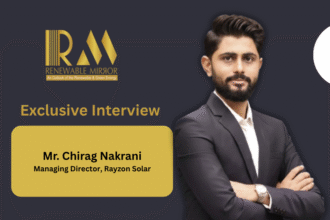Last Updated on October 6, 2025 by Author
Q.Could you share some of your company’s most significant milestones in advancing sustainable energy solutions over the past year?
The past few months have been a transformative one for DhaSh PV Technologies Limited. Among our most notable milestones, we successfully launched the DhaSh LYNC Interconnect Ribbon and Busbar, designed to deliver superior conductivity and reliability for solar modules. We also entered into a strategic joint venture for Solar Composite Frames, exclusively for the Indian market, reinforcing our commitment to strengthening the domestic solar manufacturing ecosystem. Together, these advancements not only elevate performance standards but also contribute to reducing import dependency and aligning with India’s renewable energy ambitions.
Q. How does the company envision its role in shaping the future of the renewable energy industry, and are there any groundbreaking innovations or developments on the horizon that you can share with us?
DhaSh PV Technologies is committed to playing a catalytic role in positioning India as a global hub for renewable energy innovation. Looking ahead, one of our most exciting developments is the introduction of DhaSh Cables with e-beam technology, which enhances durability, improves insulation properties, and ensures longer operational lifespans of solar installations even under extreme conditions. This innovation will set new benchmarks for reliability and safety in solar infrastructure. As pioneers in junction boxes, connectors, and now advanced interconnection and cabling solutions, we see ourselves as enablers of next-generation solar component manufacturers.
Q.How does the company integrate sustainability and environmental responsibility into its product development and service delivery to ensure both effectiveness and long-term ecological impact?
Sustainability is at the heart of our philosophy. At DhaSh, we have integrated renewable energy sources, including solar power, into our manufacturing operations, thereby directly reducing our carbon footprint. We also focus on reducing and recycling raw materials, adopting environmentally responsible practices throughout our supply chain. Additionally, our products are designed with longevity and efficiency in mind, which minimizes waste and enhances the life cycle impact of solar systems. In essence, our commitment extends beyond compliance; it is about creating products that safeguard both performance and the planet.
Q.How has your company leveraged advanced technologies to optimize energy efficiency and significantly reduce the carbon footprint for your clients?
Technology has been central to our growth story. We employ state-of-the-art automation, precision manufacturing, and rigorous testing protocols to deliver products that maximize efficiency and reliability. By enhancing the electrical and thermal performance of our components, we directly enable solar developers and EPCs to reduce system losses, achieve higher energy yields, and lower their carbon footprint. Our innovations, from connect ribbons to advanced junction boxes, are built with one purpose: to empower our clients with sustainable, future-ready solutions.
Q.Given the regulatory challenges and market volatility in the renewable energy sector, how does the company navigate these obstacles to maintain its leadership in the industry?
Navigating the complexities of regulatory frameworks and market fluctuations requires foresight and resilience. We maintain leadership by investing heavily in R&D, adopting flexible manufacturing strategies, and aligning with domestic content requirements under government policies. Our focus on indigenization not only mitigates global supply chain risks but also strengthens India’s renewable energy self-reliance. We believe in turning challenges into opportunities, whether through diversifying our product portfolio or building strategic collaborations to ensure steady, long-term growth.
Q. How has the company adapted to evolving global energy policies and the increasing consumer demand for sustainable and green energy solutions?
DhaSh has aligned its growth trajectory with both India’s national renewable energy goals 500 GW by 2030 and net-zero by 2070, and global sustainability frameworks. Our expansion into advanced interconnection, cabling, and composite solutions reflects our readiness to meet the surging demand for high-performance, eco-friendly products. By maintaining international quality standards and participating actively in global expos and collaborations, we are not only serving domestic needs but also reinforcing India’s position in the global clean energy value chain.
Q. How do you envision the renewable energy industry evolving over the next 5 to 10 years, and what steps is your company taking to stay ahead of these changes?
The next decade will be defined by technological integration, higher efficiency standards, and rapid global adoption of solar power. We foresee advancements in module design, storage integration, and smart grid solutions reshaping the renewable landscape. To stay ahead, DhaSh is investing in next-generation product development, automation-led manufacturing, and global expansion. With our 63 GW capacity roadmap already underway, we are not only preparing to meet future demand but also to set benchmarks that will define the solar industry of tomorrow.










